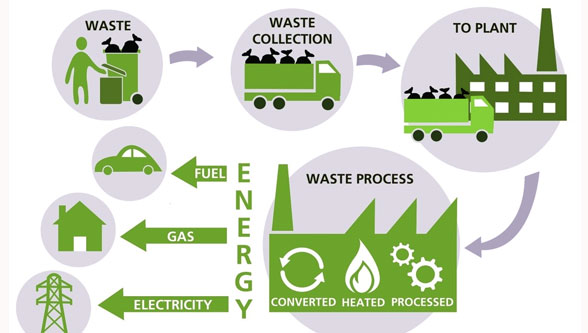
Introduction:
Waste-to-Energy (WtE) is a sustainable and innovative waste management strategy that offers a viable solution to the global waste crisis. With increasing waste generation and limited landfill space, WtE converts waste materials into valuable resources, such as heat and electricity. This article explores the concept of WtE, its historical background, key concepts, and its role in promoting environmental sustainability, economic viability, and social acceptability. It also delves into case studies, current trends, challenges, and the future outlook of WtE, emphasizing the need for continued exploration and investment in this transformative approach to waste management.
Historical Background:
The Evolution of Waste-to-Energy Technologies
Waste-to-Energy technologies have undergone significant development over the years, responding to the escalating waste management challenges faced globally. Incineration, one of the earliest forms of WtE, dates back to ancient civilizations. However, the first commercial incineration plant was established in Nottingham, England, in the late 19th century. Since then, the field has witnessed remarkable milestones and advancements.
In the mid-20th century, the advent of mass incinerators marked a turning point in WtE, scaling up waste combustion to meet the growing waste volumes. The introduction of air pollution control technologies in the 1970s ensured the reduction of harmful emissions, addressing initial environmental concerns. In the 21st century, gasification and anaerobic digestion have emerged as alternative methods for waste treatment and energy recovery, further advancing WtE technologies.
Key Concepts and Definitions:
Understanding the Core Principles of Waste-to-Energy
Waste-to-Energy encompasses various forms of waste treatment, including incineration, gasification, and anaerobic digestion. Incineration involves the combustion of waste materials, which releases heat that can be converted into electricity or used for heating purposes. Gasification converts waste into a synthetic gas, which can be utilized for electricity generation or chemical production. Anaerobic digestion involves the decomposition of organic waste in the absence of oxygen, producing biogas and nutrient-rich fertilizers.
Energy recovery from waste is a fundamental aspect of sustainable waste management. By harnessing the energy potential of waste materials, WtE reduces reliance on fossil fuels while contributing to the development of a circular economy. Unlike traditional waste disposal methods such as landfilling or open burning, WtE transforms waste into a valuable resource, promoting resource conservation and minimizing environmental impacts.
Main Discussion Points:
Environmental Benefits of WtE:
Waste-to-Energy plays a pivotal role in reducing landfill usage and associated environmental problems. Landfills are significant sources of air and water pollution, greenhouse gas emissions, and soil contamination. By diverting waste from landfills to WtE facilities, the environmental burden can be significantly reduced. Additionally, WtE has the potential to mitigate climate change by capturing methane released by decomposing organic waste in landfills, a potent greenhouse gas. By providing a sustainable alternative to fossil fuel-based energy production, WtE also contributes to resource conservation and effectively closes the loop in the circular economy.

Economic Viability of WtE:
Waste-to-Energy offers several economic advantages, making it an attractive option for waste management. Firstly, WtE facilities generate renewable energy from waste, reducing reliance on fossil fuels and contributing to a more sustainable energy mix. Waste disposal fees can also generate revenue as municipalities and waste management companies charge for the waste processed at WtE facilities. Furthermore, WtE projects have the potential to create jobs and stimulate local economic development, particularly in regions with high waste generation rates. Moreover, WtE has shown promising cost-effectiveness compared to other waste management strategies, making it a financially viable option.
Social Acceptability and Public Perception of WtE:
Public education and awareness play a critical role in shaping attitudes towards Waste-to-Energy. While concerns and misconceptions may surround WtE, scientific evidence can effectively address them. Proactive community engagement and communication strategies are essential in fostering social acceptance of WtE projects. Successful initiatives have highlighted the benefits of WtE, such as reduced landfill usage, improved air quality through modern emission control technologies, and the potential for renewable energy generation. By actively involving local communities and addressing their concerns, WtE projects can gain public support and pave the way for sustainable waste management.
Case Studies or Examples:
Success Stories in Waste-to-Energy Implementation
Numerous countries and regions have successfully implemented WtE projects, showcasing its potential as a sustainable waste management solution. For instance, Sweden has achieved remarkable success in waste management through WtE, with over 99% of household waste being utilized for energy recovery. Singapore, a city-state with limited land availability, has embraced WtE as a key pillar of its waste management strategy, demonstrating how urban areas can effectively deal with their waste while generating clean energy. These case studies highlight the challenges faced, lessons learned, and the positive impact of WtE projects on waste management practices and local communities.
Current Trends or Developments:
Advancements and Integration in Waste-to-Energy Technologies
Waste-to-Energy technologies continue to evolve, driven by the pursuit of improved efficiency and emissions control. Innovations in combustion processes, such as advanced flue gas cleaning systems, have significantly reduced air pollutant emissions, making WtE more environmentally friendly. Moreover, emerging technologies such as plasma gasification and pyrolysis offer exciting possibilities for enhancing waste treatment and energy recovery. Integration of WtE with other renewable energy sources, such as solar and wind, along with smart grid systems, presents opportunities for a more sustainable and resilient energy infrastructure.

Challenges or Controversies:
Addressing Concerns and Overcoming Obstacles
Critics of Waste-to-Energy raise concerns about potential air pollution and health risks associated with the incineration of waste. However, modern WtE facilities are equipped with state-of-the-art emission control systems that minimize the release of pollutants. Furthermore, stringent regulations and continuous monitoring ensure compliance with air quality standards. Controversies also exist regarding the use of waste as a fuel source and the potential for waste importation, as some argue that it may deter recycling efforts. Implementing WtE on a large scale poses challenges, including technology selection, financial viability, and the need for collaboration between various stakeholders. Striking the right balance between recycling initiatives and WtE implementation is crucial for sustainable waste management.
Future Outlook:
The Role of Waste-to-Energy in Global Waste Management Strategies
Waste-to-Energy holds immense promise in shaping future waste management strategies on a global scale. As the world grapples with mounting waste volumes and limited landfill space, WtE presents a sustainable solution. Policy and regulatory changes are imperative to promote the adoption of WtE technologies, enabling countries to leverage their waste as a valuable resource. Continued investment in research and development is necessary to optimize existing technologies and explore innovative approaches in WtE. By embracing WtE, nations can tackle the waste crisis while simultaneously harnessing clean energy and promoting a circular economy.
Conclusion:
The Significance of Waste-to-Energy in Sustainable Waste Management
Waste-to-Energy serves as a sustainable waste management strategy, offering solutions to the global waste crisis. Through the conversion of waste into valuable resources, WtE reduces landfill usage, mitigates climate change, and promotes resource conservation. Furthermore, it presents economic advantages, such as renewable energy generation, revenue generation, and job creation. Overcoming challenges related to social acceptability and addressing concerns through scientific evidence are essential for successful implementation. By showcasing case studies, discussing current trends, and exploring future prospects, this article highlights the pivotal role of WtE in cementing sustainable waste management practices globally.




